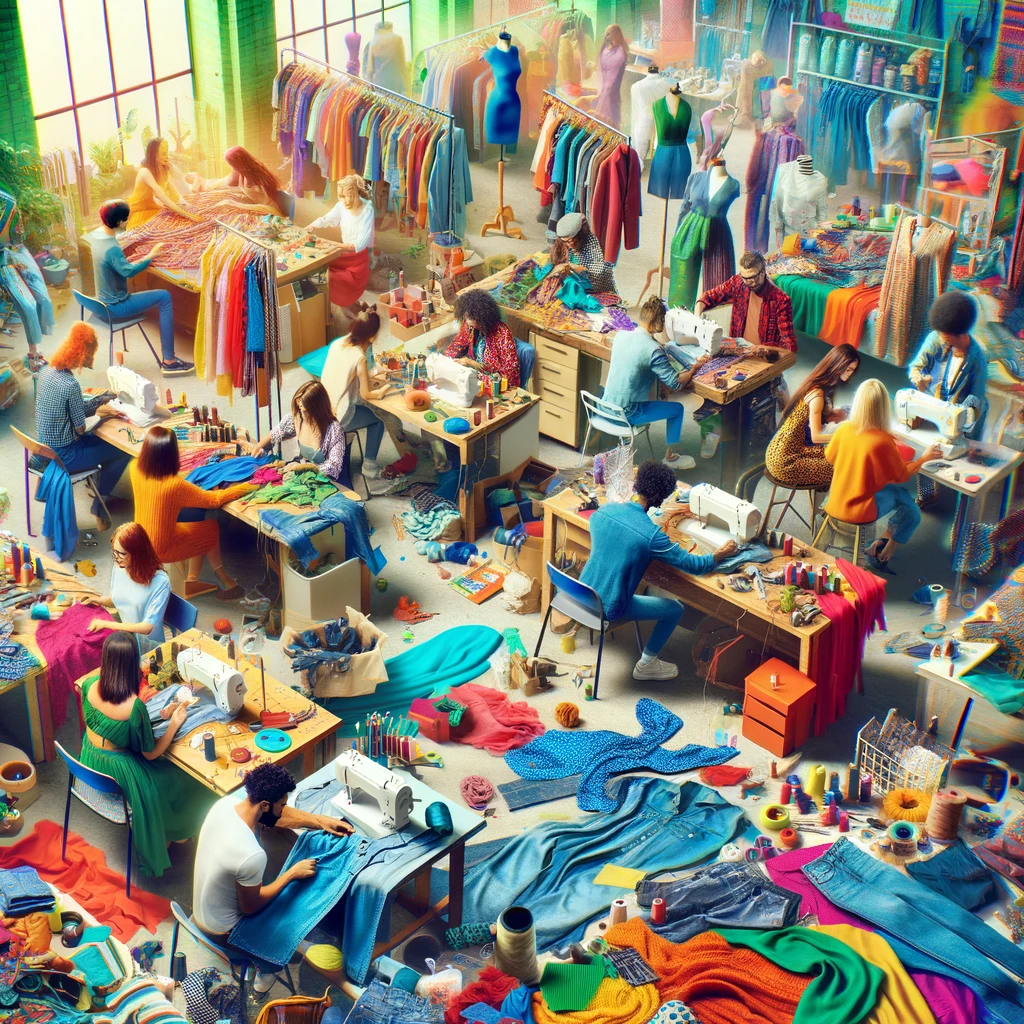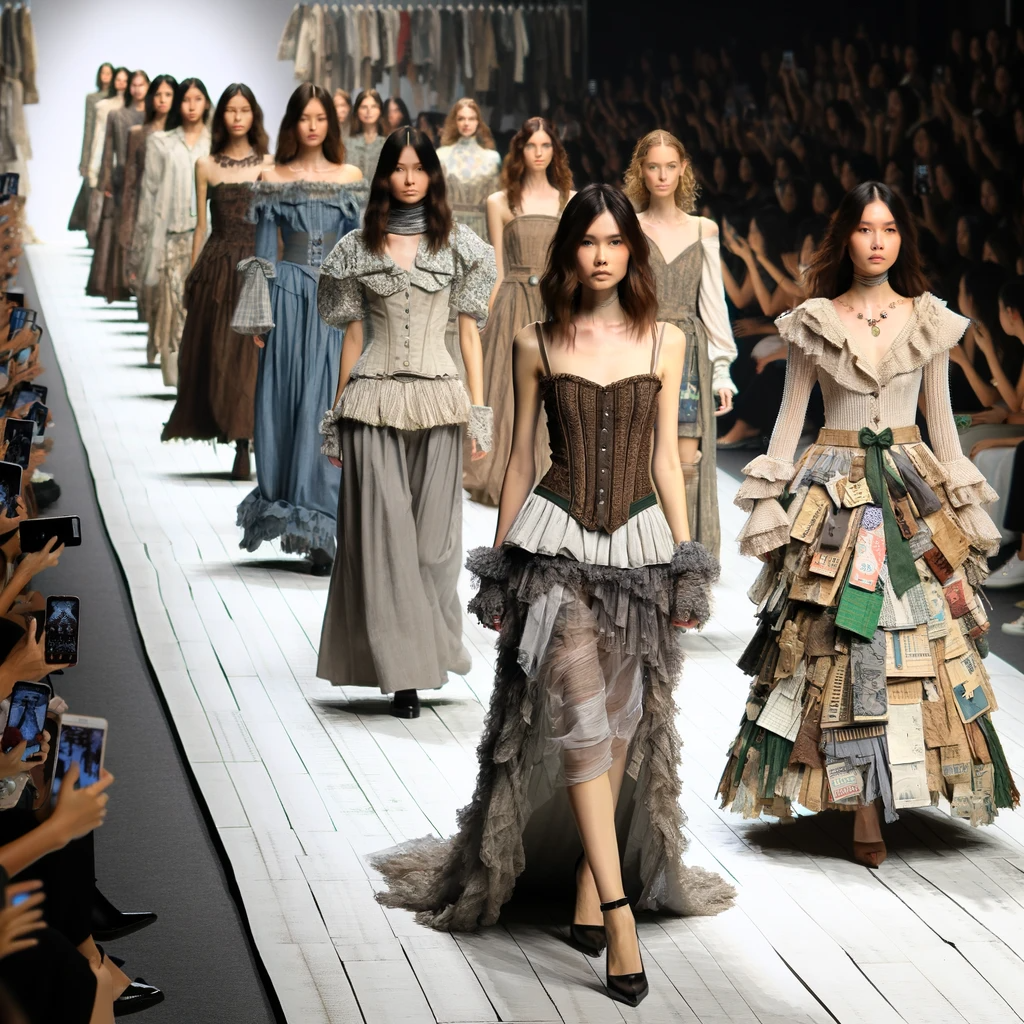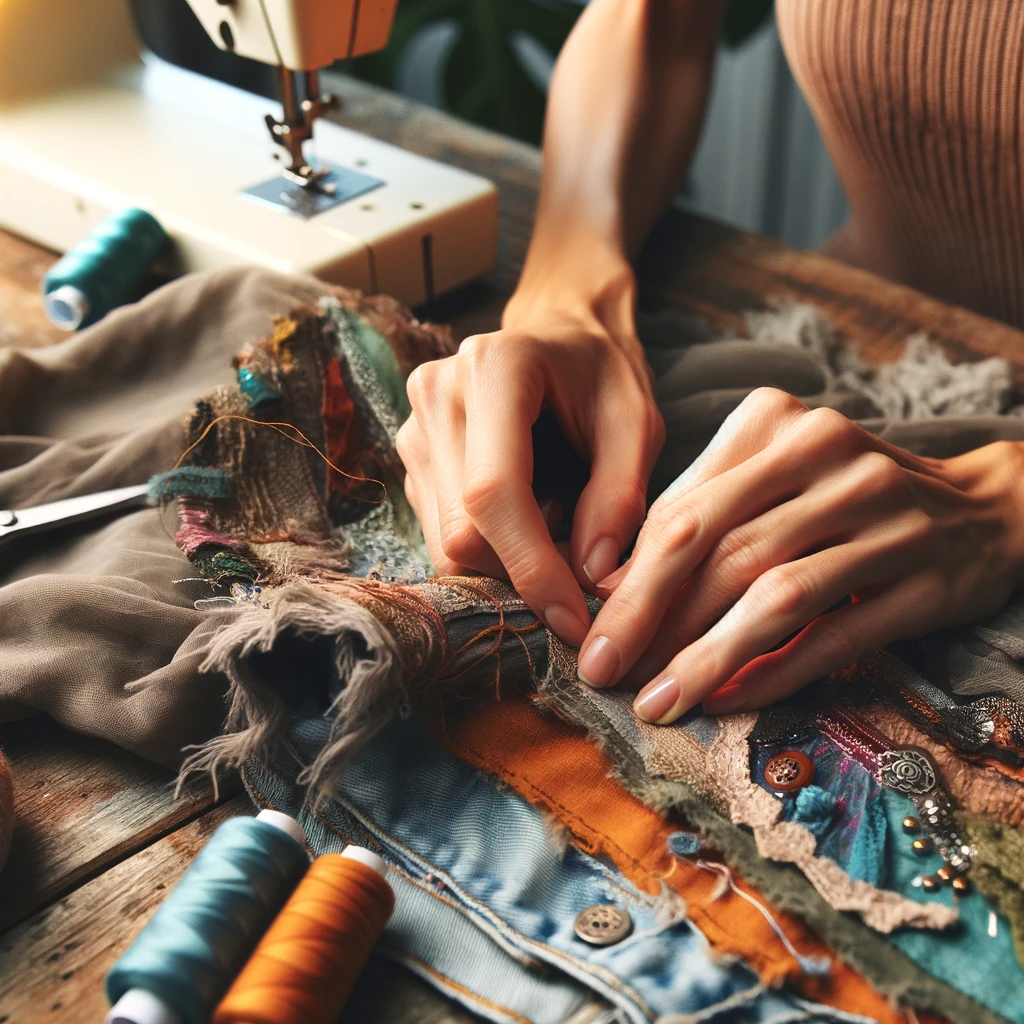Introduction: Upcycling vs Recycling in Fashion
In the dynamic world of fashion, the terms "upcycling" and "recycling" have become more than just buzzwords—they represent a movement towards sustainability and environmental responsibility. But what exactly do these terms mean, and how do they differ in the context of fashion? We are going to unpack all this and delve into the nuances of upcycling and recycling in fashion, exploring their significance, differences, and why they matter for the future of fashion and the health of our planet.
1. What is Upcycling and Recycling in Fashion?
A. Recycling in Fashion
Recycling within the fashion industry involves creative and eco-conscious approaches, such as using deadstock fabric to create new garments, offering take-back programs for old clothes, and transforming discarded clothing into useful materials like insulation or stuffing. An impressive example is ECONYL® Nylon, made from regenerated waste materials like fishing nets and old carpets, illustrating the industry's commitment to minimizing waste and conserving resources.
B. Upcycling in Fashion
Upcycling, on the other hand, adds value to existing materials or garments. Unlike recycling, which breaks down materials, upcycling creatively repurposes materials in innovative ways. It's a process that starts at the design stage and includes practices like shopping at thrift stores, online clothing rental for lesser-worn pieces, and opting for a minimalist wardrobe. Upcycling is particularly beneficial for materials that cannot be recycled, such as mixed fabric blends.
2. Key Differences Between Upcycling and Recycling
Understanding the distinctions between upcycling and recycling is crucial for informed choices in sustainable fashion. Recycling focuses on transforming objects into new materials, often involving the breakdown of materials, which can be emissions-intensive. Upcycling, in contrast, involves enhancing or transforming materials for a different or more valuable purpose without deconstructing them. The primary goal of recycling is resource reuse, while upcycling aims to create unique, high-quality products from waste.
3. Benefits of Upcycling and Recycling
Both practices offer significant environmental and economic advantages:
- Minimizing Landfill Waste: They reduce the volume of discarded materials in landfills.
- Reducing New Material Production: By reusing materials, they lower the demand for new resources, reducing carbon emissions and environmental pollution.
- Resource Efficiency: Saving monetary and environmental resources by reducing the need for new manufacturing processes.
4. How to Choose Between Upcycling and Recycling
Deciding whether to upcycle or recycle depends on various factors, including the type of material, available resources, and personal skills. Upcycling adds a creative dimension to sustainability, transforming materials into unique creations. Recycling, more practical, emphasizes the breakdown and reutilization of materials. It's important to consider certifications like "Fair Trade" when choosing upcycled or sustainably-made products.
Conclusion
As the fashion industry evolves, upcycling and recycling stand at the forefront of a sustainable future. They not only contribute to environmental preservation but also inspire a new wave of creativity and innovation in fashion. By embracing these practices, we can all play a part in reducing our ecological footprint and shaping a more responsible fashion industry.
Stay tuned for the next section where we will explore specific examples of upcycling and recycling in fashion, showcasing how these practices are being implemented by brands and designers globally.

Examples of Upcycling and Recycling in Fashion
Fashion is not just about style; it's about making a statement. With the growing awareness of environmental issues, the fashion industry is increasingly turning towards sustainable practices. Two key approaches in this shift are upcycling and recycling. In this section, we'll explore concrete examples of how these methods are revolutionizing the industry, showcasing brands and designers who are leading the way.
1. Upcycling in Fashion: A Creative Revolution
A. Creative Transformation of Existing Clothes
- Designers' Approach: Fashion designers and enthusiasts are selecting used or abandoned clothing and transforming them through sewing, cutting, embroidery, or other creative methods to create new garments or accessories. This practice not only gives a second life to clothes but also results in unique, one-of-a-kind pieces.
B. Upcycling Mixed Fabrics
- A Solution for Non-Recyclable Fabrics: For fabrics that cannot be recycled, like synthetic/natural blends, upcycling provides an opportunity to extend their lifecycle. These mixed fabrics are creatively transformed into new clothing, offering an eco-friendly solution to textile waste.
C. Examples of Upcycled Fashion
- Bespoke Fashion Items: Upcycling leads to the creation of unique fashion items, turning waste materials into stylish solutions. This process results in wearable art that appeals to those who value individuality and sustainability.
2. Recycling in Fashion: A Sustainable Practice
A. Recycling Processes in the Fashion Industry
- Breaking Down Textiles: Recycling involves collecting used textiles, breaking them down into fibers, and then reusing them to make new products. This process aims to reduce textile waste and minimize the use of virgin resources.
B. Examples of Recycled Fashion
- Innovative Use of Recycled Materials: Brands are increasingly using recycled materials like ECONYL® Nylon, made from waste like fishing nets and old carpets. These materials are transformed into high-quality, durable products, contributing to a more sustainable fashion industry.
3. The Role of Brands and Designers in Upcycling and Recycling
A. Eco Fashion Activist Brands
- Commitment to Sustainability: Brands like Aatise are setting an example by creating products such as upcycled sweatshirts and recycled jumpers. These brands focus on local and responsible production, reducing carbon emissions associated with international transport and supporting the local economy.
B. Small Businesses and Solopreneurs
- Supporting Ethical Companies: Many upcycling initiatives are run by small businesses or individual entrepreneurs. By purchasing upcycled clothing, consumers support ethical companies that prioritize sustainability over mass production.
Conclusion
The integration of upcycling and recycling in the fashion industry marks a significant step towards sustainability. By embracing these practices, fashion becomes more than just a trend; it becomes a movement towards a more responsible and environmentally conscious future. This shift not only benefits the planet but also encourages creativity and innovation, paving the way for a more thoughtful and considerate approach to fashion.

Challenges and Future Prospects of Upcycling and Recycling in Fashion: Navigating the Complexities of Sustainable Fashion
As the fashion industry shifts towards more sustainable practices, upcycling and recycling have emerged as key strategies. However, this transition is not without its challenges. In this section, we'll explore the obstacles faced by the fashion industry in implementing these practices, as well as the potential future developments in sustainable fashion.
1. The Challenges of Upcycling and Recycling
A. Technical and Material Limitations
- Mixed Fabrics: Certain mixed fabrics, especially synthetic/natural blends, present a significant challenge for recycling as they cannot be easily broken down into raw materials. Upcycling offers a solution, but it requires creativity and skill.
B. Legal and Intellectual Property Issues
- IP Rights and Upcycling: Upcycling can sometimes infringe on intellectual property rights, especially when using materials from luxury brands. Navigating the legal landscape is crucial for upcyclers to avoid IP infringement.
C. Economic Viability
- Labor-Intensive Processes: Both upcycling and recycling can be more labor-intensive compared to traditional manufacturing processes. This can affect the economic viability and scalability of sustainable fashion practices.
2. The Future of Upcycling and Recycling in Fashion
A. Technological Advancements
- Innovations in Recycling Technologies: Emerging technologies may offer solutions to current recycling challenges, making it easier and more efficient to break down and reuse a wider range of materials.
B. Increasing Consumer Awareness
- Shift in Consumer Behavior: As awareness of environmental issues grows, consumers are increasingly seeking sustainable fashion options. This demand can drive further innovation and investment in upcycling and recycling practices.
C. Collaboration and Policy Support
- Industry and Government Initiatives: Collaborative efforts between fashion brands, governments, and NGOs can play a pivotal role in overcoming the challenges of sustainable fashion. Policies that support sustainable practices can encourage more brands to adopt upcycling and recycling.
Conclusion
While there are challenges to implementing upcycling and recycling in fashion, the future looks promising. With technological advancements, growing consumer awareness, and supportive collaborations, sustainable fashion practices can become more mainstream. The fashion industry has the potential to transform into a more environmentally responsible and ethically conscious sector, leading the way towards a more sustainable future.

Practical Tips and Strategies for Upcycling and Recycling in Fashion: Embracing Sustainable Fashion in Everyday Life
As we've explored the significance, challenges, and future prospects of upcycling and recycling in fashion, it's clear that these practices are vital for a sustainable future. But how can individuals participate in this movement? This section provides practical tips and strategies for consumers to engage in upcycling and recycling, making sustainable fashion a part of everyday life.
1. Tips for Upcycling Your Wardrobe
A. DIY Upcycling Projects
- Get Creative with Old Clothes: Look for ways to transform old clothes into fresh, new pieces. With basic sewing skills, you can refashion a t-shirt into a summer dress or add embellishments to an old jacket.
B. Supporting Upcycling Brands
- Choose Products from Upcycling Brands: Support small businesses and solopreneurs who specialize in upcycled fashion. Purchasing their products not only promotes sustainability but also encourages the growth of ethical companies.
2. Recycling Your Clothing Responsibly
A. Recycling and Donation Options
- Find Local Recycling Programs: Look for organizations or companies that offer clothing recycling services. Avoid throwing clothing into general waste and explore options for donating wearable items to second-hand stores.
B. Understanding Fabric Recyclability
- Know Your Fabrics: Familiarize yourself with the types of fabrics that can be recycled. This knowledge will help you make informed decisions about purchasing and disposing of clothing.
3. Supporting Sustainable Fashion Brands
A. Choosing Eco-Conscious Brands
- Research Brands' Sustainability Practices: Look for brands that prioritize upcycling and recycling in their production processes. Use resources like the Good On You directory to find ethical fashion brands.
B. Advocating for Sustainable Policies
- Encourage Policy Changes: Advocate for policies that support sustainable fashion practices. This can include supporting initiatives that encourage recycling and upcycling in the fashion industry.
4. Raising Awareness and Education
A. Sharing Knowledge
- Educate Others: Share your knowledge about sustainable fashion with friends and family. Encourage discussions about the importance of upcycling and recycling in reducing the fashion industry's environmental impact.
B. Participating in Community Initiatives
- Join Community Efforts: Participate in local events or campaigns focused on sustainable fashion. Community involvement can amplify the message and encourage more people to embrace sustainable practices.
Conclusion
By incorporating these practical tips and strategies into our daily lives, each of us can contribute to a more sustainable future in fashion. Upcycling and recycling not only reduce waste and environmental impact but also foster creativity and individuality in our wardrobes. As consumers, our choices and actions can drive significant change in the fashion industry, steering it towards a more responsible and eco-friendly future.

